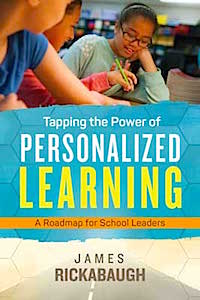A Personalized Learning Guide for Leaders
Tapping the Power of Personalized Learning: A Roadmap for School Leaders
By James Rickbaugh
(ASCD 2016 – Learn more)
Although I am quite familiar with personalized learning and have used it for some time in my classroom, I find teachers are overwhelmed by the idea and expect personalized learning means that every student will end up with formal paperwork.

This is the message that administrators need to get across to teachers, AND this is a great book for teachers to read to alleviate their fears and further understand personalized learning.
What you’ll find in the book
With its helpful diagrams that can be re-used with staff, bulleted concepts, and numbered sections setting off ideas in a clear organizational format, this is a user-friendly book for administrators to use. At 148 pages with a minimal glossary that will help teachers who are either new or resistant to the topic, it is a quick read.
I came away with multiple ideas to use in my beginning-of-the-year department meeting that helps my teachers better understand how to help each of our students own their learning. Rickbaugh’s suggestions can be implemented in the classroom, department, and school-wide levels, which is not always the case when reading leadership manuals.
Often instructional books have great ideas and then send the reader off to figure out implementation. This author takes a different approach. Throughout each chapter, activity protocols, observation walk-throughs to gather information, and reflective questions are provided that help the educator actually put the book’s concepts into action.
These reflective questions ask us to think through the barriers we face and what may hinder our progress. Rickbaugh even goes so far as to provide a sample action plan at the end.
Not written in an ivory tower
This is not an “ivory tower” book. The author discusses his own successes as an educator with personalized learning. More meaningfully, administrators from across the United States are quoted as to how they have used Rickbaugh’s ideas and their successes. For me, this provides extra validation. I want to know if these ideas are really going to work or they just sound good.
The author uses an entire chapter to discuss how students need to understand the purpose of their learning and then own it. This rang true to me and also spurred me into action: It is not just enough for a teacher to write an “I can…” statement on the board or a list of standards that will be covered that day in class. Students need to understand and be able to explain not only what they are doing but why they are doing it.
When students can really explain why they are completing a task in school, they are closer to owning it. Additionally, the author deals with the concern that sometimes it is difficult to get student buy-in – whether it is building interest in the course topic or engaging the student in doing the work at all. Rickbaugh admits there are no easy answers for this issue, but he does make suggestions. I like when a book is honest with me and doesn’t claim that a new initiative is going to be all blossoming roses.
A helpful handle on how to actually pull it all together
“The Honeycomb Model” in chapter 2 stands out to me as a section which will help faculty get a better handle on how so many instructional pieces can come together to create this personalized student-centered learning. This honeycomb model is repeated throughout the book.
Some of the honeycombs included are learner voice, cultural responsiveness, rapid cycle feedback, standards, and learner profiles. I especially like that the author does not shy away from talking about standards. Although I do think that he could have given more attention to how vital mastery-based learning and grading – which use standards — are, related to personalized learning.
Overall, I found this book to be well worth my time. If you are an administrator who does not have a lot of experience with this topic, the book will be valuable. I recommend it to any administrator who may have an interest in putting personalized learning into action or improving it in his or her school.
And if you are a teacher interested in learning more about personalized learning, pick up this text; don’t be turned off because the title includes the words school leaders: This book is for you too!
As middle school Literacy/Instructional Coach and high school English Chair in New Fairfield Schools, New Fairfield, Connecticut, Debbie Parker works with English and content areas teachers to understand and implement personalized learning with high impact instructional strategies to create effective Tier 1 classrooms for improved comprehension and writing. She is a member of our school grant committee through the NESSC/Great Schools Partnership; personalized learning is emphasized, and Debbie is a strong believer in it. She blogs at Putting the Pieces Together in the Classroom.



































